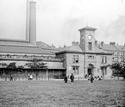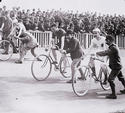 The building boom of the 1830s had an ambiguous effect on the development of sport in Glasgow. Suburbanisation reflected middle-class determination to move away from the congested inner city and the resulting shift in residential patterns meant that some of the old sporting institutions declined. Thus, Glasgow Golf Club folded during the 1830s, its members unhappy about the proximity of East End industry to their course at Glasgow Green. On the other hand, the outlying districts offered ample space for sporting activity. Bowling clubs, such as Partick (1845), Govan (1847) and Hillhead (1849), represented a popular recreational refinement to the suburban landscape.
The building boom of the 1830s had an ambiguous effect on the development of sport in Glasgow. Suburbanisation reflected middle-class determination to move away from the congested inner city and the resulting shift in residential patterns meant that some of the old sporting institutions declined. Thus, Glasgow Golf Club folded during the 1830s, its members unhappy about the proximity of East End industry to their course at Glasgow Green. On the other hand, the outlying districts offered ample space for sporting activity. Bowling clubs, such as Partick (1845), Govan (1847) and Hillhead (1849), represented a popular recreational refinement to the suburban landscape.
 By mid-century Glasgow Corporation was promoting the health value of the city's public parks. Queen's Park had emerged on south-side farmland from 1857 and its extensive recreation ground was intended to meet demand from sporting enthusiasts. It was here that Queen's Park, Scotland's oldest association football club, was founded in 1867. The reconstituted Glasgow Golf Club also used the ground between 1870 and 1875, but then moved back east, to a course at the new Alexandra Park. Swimming was another cause taken up by the Corporation. The first purpose-built municipal baths opened at Greenhead, Bridgeton, in 1878. Private swimming establishments, such as the West End's Arlington Baths (1869-71) and Western Baths (1876-81), became popular with the middle classes.
By mid-century Glasgow Corporation was promoting the health value of the city's public parks. Queen's Park had emerged on south-side farmland from 1857 and its extensive recreation ground was intended to meet demand from sporting enthusiasts. It was here that Queen's Park, Scotland's oldest association football club, was founded in 1867. The reconstituted Glasgow Golf Club also used the ground between 1870 and 1875, but then moved back east, to a course at the new Alexandra Park. Swimming was another cause taken up by the Corporation. The first purpose-built municipal baths opened at Greenhead, Bridgeton, in 1878. Private swimming establishments, such as the West End's Arlington Baths (1869-71) and Western Baths (1876-81), became popular with the middle classes.
 By the 1870s many sporting clubs were constructing larger grounds to accommodate spectators. In 1876 Clydesdale Cricket Club moved from Kinning Park to a more commodious base at Titwood. Rangers Football Club took over the old ground, but the modern Ibrox Park dates from 1899. Celtic's Parkhead stadium was inaugurated in 1892, while the elaborate and expensive Hampden Park, home of Queen's Park, opened in 1903. Other sports extended their appeal through the use of specialised buildings. Curling was a notable example. This popular pursuit had hitherto depended on wintry weather, but in 1907 Scotland's first indoor rink with artificial ice was built at Crossmyloof.
By the 1870s many sporting clubs were constructing larger grounds to accommodate spectators. In 1876 Clydesdale Cricket Club moved from Kinning Park to a more commodious base at Titwood. Rangers Football Club took over the old ground, but the modern Ibrox Park dates from 1899. Celtic's Parkhead stadium was inaugurated in 1892, while the elaborate and expensive Hampden Park, home of Queen's Park, opened in 1903. Other sports extended their appeal through the use of specialised buildings. Curling was a notable example. This popular pursuit had hitherto depended on wintry weather, but in 1907 Scotland's first indoor rink with artificial ice was built at Crossmyloof.